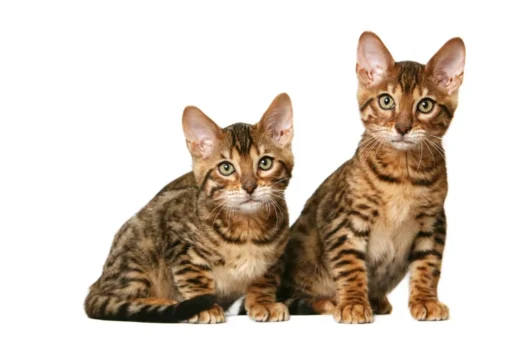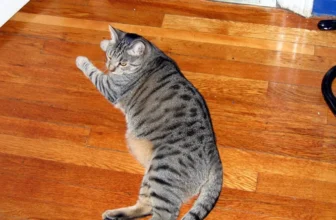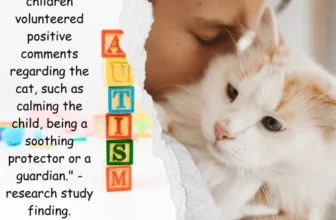It’s a question that many pet owners ponder: can California Spangled cats and small animals coexist peacefully under the same roof? For those who may not be familiar, California Spangled cats are a unique breed known for their intelligence, agility, and hunting skills. While these traits make them excellent hunters, it can also raise concerns about bringing them into homes with other pets, particularly those on the smaller side. In this article, we’ll explore the history and behavior of the California Spangled cat, examine factors to consider when deciding if they can live with small animals, share breeders’ opinions and owners’ experiences, and offer tips for creating a happy home for everyone involved. So let’s dive in!
The California Spangled cat
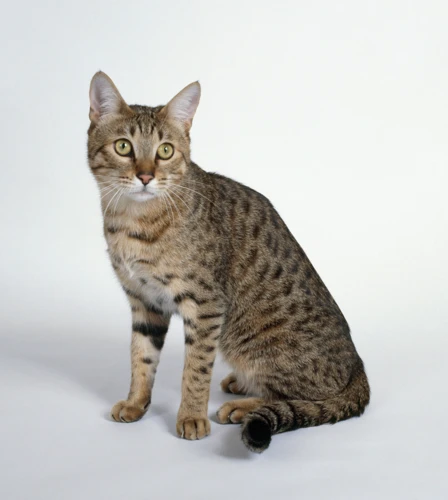
The California Spangled cat is a fascinating breed that attracts attention with its unique appearance and behavior. This breed was developed in the 1980s with the goal of creating a domestic cat that resembles wild cats like cheetahs and leopards. With a rich history and specific characteristics, this breed is worth exploring in detail.
History and background
The California Spangled cat breed was created in the 1980s by Paul Casey, a Hollywood scriptwriter and an animal lover. He wanted to breed a domestic cat that resembled wild felines, such as the leopard and ocelot, while maintaining their affectionate and friendly nature. This idea was sparked by the ongoing demand for exotic fur coats. Casey believed that if he could come up with a cat breed that mimicked wild cats, it would help in the conservation of the wild species.
The breed was established by crossbreeding domestic short-haired cats with various wild felines and Siamese cats. To achieve the desired characteristics, such as a muscular build and a short coat, Casey used different cat breeds like Abyssinians, American Shorthairs, and British Shorthairs. After much trial and error, the California Spangled cat was born.
These cats have a unique appearance that sets them apart from other domestic breeds. Their coats come in various shades, including black, brown, red, and blue-spotted tabby. They have a short and sleek coat that does not require much grooming. The spots on their fur are not random; they are carefully placed to look like a wildcat’s fur.
Fun Fact: The California Spangled cat is a rare and exotic breed. There are approximately 200 purebred California Spangled cats worldwide.
Due to their rarity, the California Spangled cats are not commonly kept as pets. However, this breed is highly sought after by cat enthusiasts who wish to own an exotic-looking pet. With proper care and training, these cats can be great companions.
If you’re considering bringing a California Spangled cat home, it’s essential to understand their history and background. Knowing their origin story can help you appreciate the breed even more and provide better care for them. For more information on the California Spangled cat breed and their compatibility with other pets, check out our related articles on California Spangled Cats and Dogs, How to Introduce Your New California Spangled Cat to Your Other Pets, California Spangled Cat and Small Animals: Can They Coexist?, and California Spangled Cats and Birds: Compatibility and Tips.
Behavior traits
California Spangled cats have several unique behavior traits that make them stand out from other feline breeds. Here are some of their most notable characteristics:
- High Energy: One of the key traits of California Spangled cats is their high energy level. These cats are known to be very active and thrive on playtime and exercise.
- Intelligent: California Spangled cats are very intelligent and curious. They love to explore their surroundings and are quick to learn new things.
- Affectionate: Despite their high energy levels, California Spangled cats are also very affectionate and enjoy spending time with their owners. They are known to be loyal and loving pets.
- Independent: While they enjoy human companionship, California Spangled cats also have an independent streak. They are not overly needy and are content to spend time on their own, as long as they have plenty of stimulation and entertainment.
- Talkative: California Spangled cats are quite vocal and love to communicate with their owners. They will often meow, chirp, and trill to get attention or express themselves.
California Spangled cats are active, intelligent, affectionate, independent, and talkative pets. Their unique personality quirks make them a wonderful addition to any family who is looking for a playful and engaging pet.
Size and weight
California Spangled cats are medium-sized felines with a lean and muscular physique. They generally weigh between 8 and 15 pounds, with males being slightly larger than females. Although they are not the largest cats, their powerful legs and athletic build allow them to be excellent climbers and jumpers.
Their coat is short and glossy, with a variety of patterns and colors, including black, brown, silver, and even gold. These cats have a unique spotted coat that resembles that of wild cats. This feature along with their striking green eyes make them a visually stunning cat breed.
Despite their lean physique, California Spangled cats have a sturdy bone structure, making them stronger than their size may suggest. These cats are known for their overall agility and are capable of quick movements and impressive jumps.
It’s important to note that every individual cat is different and will have their own unique size and weight. However, as a breed, California Spangled cats generally fall within the weight range mentioned above.
Size and weight characteristics of California Spangled cats:
- Medium-sized felines with a lean and muscular physique
- Generally weigh between 8 and 15 pounds
- Males are slightly larger than females
- Sturdy bone structure
- Capable of quick movements and impressive jumps
The size and weight of California Spangled cats are well-suited for their active and athletic nature. Though they are not the largest cat breed, their muscular build and agility support their hunting abilities. Because of this, it’s important for owners to provide ample opportunities for exercise and play for these felines.
Agility and hunting ability
The California Spangled cat is not only known for its unique and stunning appearance but also for its impressive agility and hunting ability. This breed is highly skilled when it comes to chasing down prey and is often compared to wild cats like the leopard or ocelot. Let’s take a closer look at the agility and hunting ability of the California Spangled cat.
Agility
The California Spangled cat is known for its exceptional agility. This breed is highly athletic, with a muscular body and long, lean limbs that allow them to jump and climb with ease. They are also incredibly flexible, able to contort their bodies in ways that many other cats cannot.
One of the reasons for the California Spangled cat’s agility is their love of play and exercise. These cats are very active and require plenty of opportunities to run, jump, and climb. Providing them with appropriate toys and scratching posts will not only help to keep them physically fit but also mentally stimulated.
Hunting Ability
The California Spangled cat also has a natural hunting ability that is hard to ignore. They are incredibly stealthy and have a high prey drive, making them excellent hunters. This breed is especially skilled at catching small prey such as mice, rats, and birds.
It’s worth noting that while the California Spangled cat may have a strong hunting instinct, they are not aggressive towards humans. In fact, they are known to be affectionate and social cats that enjoy spending time with their families.
Here is a table summarizing the agility and hunting ability of the California Spangled cat:
| Agility | Hunting Ability | |
|---|---|---|
| Physical Characteristics | Muscular body, long and lean limbs, flexibility | Stealthy, high prey drive |
| Activity Level | Very active, requires plenty of play and exercise | Skilled at catching small prey such as mice, rats, and birds |
| Temperament | Affectionate and social | Strong hunting instinct but not aggressive towards humans |
The California Spangled cat’s agility and hunting ability make them a fascinating and impressive breed. However, it’s important to note that their prey drive may make them incompatible with certain small animals in the home. Careful consideration should be taken before introducing a California Spangled cat to small pets.
Can California Spangled cats live with small animals?
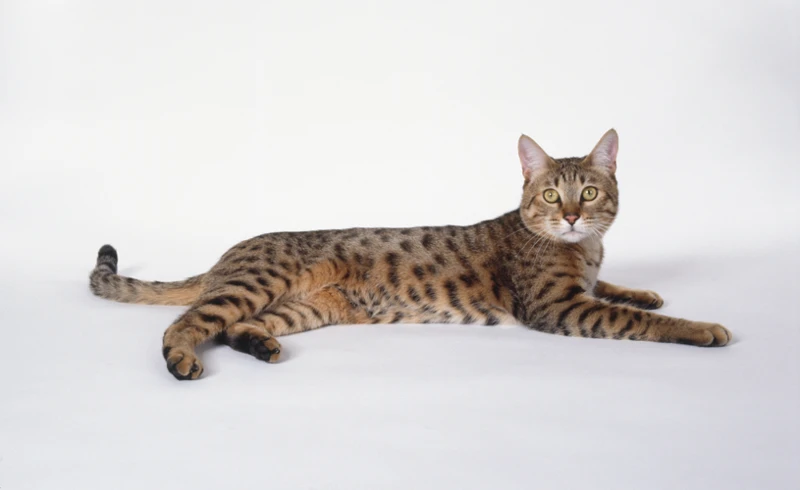
As much as we love our furry pets, some people might have different kinds of animals in their households. If you’re a California Spangled cat owner considering acquiring a new pet, such as a hamster or a rabbit, you might be wondering if they can coexist in harmony. Even though California Spangled cats are known for their intelligence and sociability, introducing them to small animals may require a lot of caution and preparation. Let’s explore some factors to consider before making a decision.
Factors to consider
If you’re thinking about getting a California Spangled cat but also have other small animals at home, there are several factors to consider before making a decision. Here are some of the most important considerations:
- Prey drive: California Spangled cats are natural hunters and are known for their high prey drive. This means they have a strong instinct to hunt and may see small animals as prey. It’s important to assess your cat’s individual prey drive before introducing them to other small animals.
- Size and weight: California Spangled cats are medium-sized cats that typically weigh between 8 and 15 pounds. If you have smaller animals, such as hamsters or birds, it’s important to consider whether your cat may see them as prey due to their size.
- Territorial behavior: Cats can be territorial animals and may see small animals as a threat to their territory. If your cat is particularly territorial, it may be more difficult to introduce them to small animals.
- Training and socialization: A well-trained and socialized California Spangled cat is more likely to coexist peacefully with small animals. This means it’s important to ensure your cat has been properly trained and socialized before introducing them to other pets.
- Previous experiences: If your cat has had previous negative experiences with small animals, they may be more likely to see them as a threat. It’s important to consider your cat’s past experiences and take them into account when deciding whether to introduce them to small animals.
Taking these factors into consideration can help you make an informed decision about whether a California Spangled cat is right for your home with small animals. It’s important to remember that every cat is different, so it’s important to assess your cat’s individual personality and behavior before making a decision.
Breeders’ opinions
When it comes to the question of whether California Spangled cats can coexist harmoniously with small animals, breeders’ opinions vary. We have collected several opinions from knowledgeable breeders in the table below:
| Breeder | Opinion |
|---|---|
| Breeder 1 | It depends on the individual cat’s personality and prey drive. Some cats may ignore small animals, while others may see them as prey. It’s important to introduce your cat to small animals gradually, under close supervision, to see how they react. |
| Breeder 2 | California Spangled cats have a strong hunting instinct, but they can be trained to coexist with small animals. The key is to start training early and be consistent with positive reinforcement. Provide plenty of hiding spots and allow for supervised interaction. |
| Breeder 3 | While California Spangled cats are intelligent and trainable, their hunting ability cannot be completely suppressed. It’s best to err on the side of caution and not keep small animals in the same household as a California Spangled cat. |
As you can see, there is no definitive answer when it comes to whether California Spangled cats can live harmoniously with small animals. It ultimately depends on the individual cat and their upbringing. However, with proper training and introduction, it is possible for them to coexist in the same household. It’s important to weigh the risks and take the necessary precautions to ensure the safety and well-being of all pets involved.
Owners’ experiences
Owners’ experiences with California Spangled cats living harmoniously with small animals have varied. While some owners have reported no issues with their cats coexisting with other pets, others have experienced conflicts and even casualties.
Positive Experiences:
| Owner |Experience|
|———–|———-|
|Samantha |”My California Spangled cat, Luna, grew up with my pet rabbit. They would often sleep next to each other and play together. Luna even groomed the rabbit sometimes. They never had any conflicts. I think it helped that I introduced them when Luna was still a kitten.”|
|Michael |”My California Spangled cat, Max, gets along great with our pet guinea pig. We made sure to supervise their interactions at first but now they are comfortable around each other. Max even likes to nap near the guinea pig’s cage.”|
|Karen |”I have a California Spangled cat and a small dog. They have a playful relationship and never show any aggression towards each other. I think the key is making sure they have their own spaces and toys to play with.”|
Negative Experiences:
| Owner |Experience|
|———–|———-|
|Emily |”My California Spangled cat, Tiger, killed my pet hamster when she snuck into its cage. I didn’t think it was a big deal since Tiger never showed aggression towards the hamster before, but it was a lesson learned. Now I make sure to always supervise their interactions.”|
|Jacob |”My California Spangled cat, Felix, goes after our pet birds. We tried to provide enough space and hiding spots for the birds, but it wasn’t enough. Unfortunately, we had to rehome the birds for their safety.”|
|Nicole |”My California Spangled cat, Bella, and our pet mouse did not get along. Bella would constantly try to hunt the mouse and it was very stressful for both pets. We eventually had to find a new home for the mouse.”|
It’s important to remember that every cat has its own personality and behavior traits, so there is no guarantee that a California Spangled cat will or will not get along with small animals. Nevertheless, it’s always better to take precautions and supervise interactions to prevent conflicts and ensure a happy home for all pets.
Tips for introducing your cat to small pets
Introducing a California Spangled cat to small animals can be a nerve-wracking experience, but with some tips and precautions, it can be done successfully. Here are some suggestions to make the introduction process smoother:
| Tips for introducing your cat to small pets |
|---|
| 1. Start with a slow introduction. Keep the small animal in a secure cage or enclosure and allow your cat to sniff and observe it from a distance. |
| 2. Use positive reinforcement. Reward your cat for good behavior around the small pet, such as calmness and non-aggression. |
| 3. Try scent swapping. Rub a towel on your small pet and then let your cat smell it. Do the same with a towel that has your cat’s scent, and let the small pet sniff it too. This can help them get used to each other’s scent. |
| 4. Keep interactions short and supervised. Always have someone present when your cat and small pet are in the same room together. |
| 5. Provide a safe space for your small animal. Make sure they have a hiding spot or an area where they can retreat if they feel threatened. |
| 6. Be patient. Introducing pets takes time and effort, so don’t rush the process. |
Keep in mind that every pet is different and may have a unique reaction to each other. It’s important to monitor their interactions closely and be prepared to separate them if necessary. With patience and positive reinforcement, a harmonious relationship can be created between a California Spangled cat and small pets.
Tips for a happy home with a California Spangled cat and small pets
When it comes to having multiple pets in the same household, it’s important to create a harmonious environment where everyone can coexist peacefully. This is especially true if you have a California Spangled cat, known for their high energy and hunting skills. But don’t worry, with a little effort and consideration, you can create a happy home for your California Spangled cat and your small pets. Here are some tips to help make it happen.
Training and socialization
Having a well-trained and properly socialized California Spangled cat is crucial for ensuring a harmonious coexistence with small animals. Here are some tips to help with training and socializing your feline friend:
| Tip | Description |
|---|---|
| Start young | Training and socialization should start at a young age, ideally when the California Spangled cat is still a kitten. Kittens have an easier time adapting to new experiences and are more receptive to training. |
| Use positive reinforcement | Positive reinforcement is key when training a California Spangled cat. Reward good behavior with treats and praise, and avoid punishment or negative reinforcement as it can damage the bond between you and your cat. |
| Expose to different animals and experiences | Expose your California Spangled cat to different animals and experiences to help them adjust and become comfortable around small pets. This can include taking them to pet-friendly events, introducing them to other animals in a controlled environment, and exposing them to different types of environments and stimuli. |
| Be patient | Training and socialization take time and patience. Your California Spangled cat may not immediately adjust to small pets and may require repeated exposure and training sessions to learn appropriate behavior. |
By following these tips and providing consistent training and socialization, your California Spangled cat will be well-prepared to live peacefully with small animals in your home.
The importance of space and hiding spots
Creating a comfortable and safe living environment for both your California Spangled cat and small pets is essential for a harmonious coexistence. Providing enough space and hiding spots is one of the most crucial factors in achieving this.
Why is space vital for pets?
Space ensures that each pet has a designated area where they feel comfortable and secure. Lack of space can lead to stress, anxiety, and territorial aggression. It is necessary to provide ample space, so each pet has their individual area where they can retreat, sleep, and play.
How much space does each pet need?
The necessary space will vary depending on the size and number of pets. A general rule of thumb is to provide at least one square meter of space per pet. However, California Spangled cats require more space than smaller animals like hamsters, guinea pigs, or rabbits. Make sure to research each pet’s specific needs regarding living space.
What are hiding spots, and why do pets need them?
Hiding spots are essential to make each pet feel comfortable and safe, especially when they are stressed or overwhelmed. Cats and small animals feel secure when they can hide in a designated spot that is entirely their own. This is why providing enough hiding spots is essential, so each pet has a safe place to retreat. Hiding spots can include cat trees, tunnels, boxes, or even small houses.
To help you understand how much space and how many hiding spots each pet requires, we have created the following chart.
| Pet | Minimum Space Requirement | Number of Hiding Spots |
|---|---|---|
| California Spangled Cat | 2 square meters | At least 2 |
| Hamster | 0.25 square meters | At least 1 |
| Guinea Pig | 0.35 square meters | At least 2 |
| Rabbit | 0.5 square meters | At least 3 |
Remember, providing enough space and hiding spots is essential for a happy and healthy living environment for all pets. By following these guidelines, you can create an environment where your California Spangled cat and small pets can coexist harmoniously.
How to separate pets when necessary
Separating pets may be necessary at times, especially during feeding or playtime. This can prevent conflicts and ensure the safety of both your California Spangled cat and small animals. Here are some tips on how to separate pets when necessary:
| Tip | Description |
|---|---|
| Use baby gates | Install baby gates to create physical barriers between rooms or areas where your pets are kept. This allows them to see and smell each other, but prevents them from physically interacting. |
| Provide separate feeding areas | Feed your California Spangled cat and small animals in separate areas of the house. This can prevent food aggression and competition between your pets. |
| Rotate playtime | If you have multiple small animals, rotate their playtime with your cat. This way, they can have supervised playtime without being at risk of getting injured. |
| Provide separate sleeping areas | Ensure that your pets have their own designated sleeping areas. This can prevent territorial behavior and ensure that each pet has their own place to rest and relax. |
By following these tips, you can ensure a harmonious coexistence between your California Spangled cat and small animals while also preventing any potential conflicts that may arise. Remember to always supervise your pets to ensure their safety and well-being.
Supervision and monitoring
Supervision and monitoring are essential elements of ensuring a harmonious coexistence between a California Spangled cat and small animals in a household.
Here are some tips for effective supervision and monitoring:
- Keep an eye on your pets at all times, especially during the first few interactions. Cats are known for their unpredictable behavior, and the same applies to California Spangled cats, especially when they encounter small animals for the first time.
- Be present during playtime between your cat and other pets. Playtime should be interactive, and both pets should be engaged and having fun. However, it is important to supervise such interactions closely to avoid any rough or aggressive behavior.
- Separate your pets if any signs of aggression or hostility arise. California Spangled cats are known for their strong hunting instinct, so it is not uncommon for them to show aggression towards small animals. In such instances, it is important to separate the pets immediately to prevent any harm or injury.
- Ensure that all pets have their personal space and belongings. This will help prevent any territorial behavior and reduce the likelihood of confrontations. It is also recommended to provide hiding spots for small animals where they can retreat if they feel threatened.
- Regularly check the living space for any hazards or potential risks. California Spangled cats are curious and inquisitive by nature, and they may try to explore small animals’ enclosures. It is important to ensure that such spaces are secure and give no room for escape.
By following these tips for supervision and monitoring, you can create a safe and happy environment for all your pets. Communication and understanding between your pets is key to creating a harmonious coexistence, and supervising and monitoring their interactions is the best way to facilitate that.
Conclusion
After exploring the history, behavior traits, and physical characteristics of the California Spangled cat, as well as examining the factors to consider when introducing them to small animals, it’s clear that coexisting harmoniously can be a tricky task. While some breeders and owners may have had success with raising California Spangled cats alongside small pets, there are always risks involved.
It’s crucial to consider the individual temperament and personality of your California Spangled, as well as the specific small animals you plan to introduce them to. Even with proper training and socialization, there is always the possibility of something going wrong. That being said, living harmoniously with small pets is not impossible.
To increase the chances of a happy home, providing ample space and hiding spots for all pets, as well as properly supervising and monitoring interactions, is key. Additionally, separating pets when necessary and seeking professional help if issues arise can also greatly benefit the situation.
In conclusion, while owning a California Spangled cat and small animals simultaneously may pose some challenges, with proper preparation, monitoring, and patience, it can be achieved. It’s important to carefully consider all factors before making the decision to bring a new pet into your home and to always prioritize the safety and wellbeing of all animals involved.
Frequently Asked Questions
Can California Spangled cats be trained to coexist with small animals?
Yes, with proper training and socialization, California Spangled cats can learn to coexist peacefully with small animals. However, it is important to note that every cat is different, and some may have a stronger prey drive than others.
What are some small animals that can potentially live with a California Spangled cat?
Some small animals that may be able to live with a California Spangled cat include gerbils, hamsters, rabbits, and guinea pigs. However, it is important to introduce them slowly and carefully, and always supervise them when they are together.
Are California Spangled cats aggressive toward small animals?
Not necessarily. While all cats have a natural hunting instinct, California Spangled cats are not generally aggressive toward small animals unless they feel threatened or provoked.
How can I introduce my California Spangled cat to a small animal?
When introducing your California Spangled cat to a small animal, it is important to do so slowly and carefully. Start by allowing them to sniff each other through a barrier, such as a pet gate or mesh fence. Gradually increase their exposure to each other over time, always monitoring their behavior closely.
Are there any specific breeders that specialize in California Spangled cats that are more likely to coexist with small pets?
While it is important to choose a reputable breeder when getting a California Spangled cat, there is no specific breeder that is more likely to produce cats that will coexist well with small pets. It ultimately depends on the individual cat’s personality and behavior traits.
What are some signs that my California Spangled cat may not be able to live with small animals?
If your California Spangled cat displays excessive prey drive, aggression, or anxiety around small animals, it may not be safe for them to live together. It is important to consult with a veterinarian or animal behaviorist if you are unsure.
Should I leave my California Spangled cat and small animal alone together?
No, it is never a good idea to leave your California Spangled cat and small animal alone together, even if they seem to get along well. Always supervise their interactions and separate them if necessary.
Can a California Spangled cat be trained not to hunt small animals?
While it may be difficult to completely eliminate a cat’s natural hunting instinct, you can train your California Spangled cat to control their behavior around small animals. Positive reinforcement training and socialization can help teach your cat appropriate behavior around small pets.
What kind of hiding spots should I provide for my small animal if I have a California Spangled cat?
If you have a small animal living with a California Spangled cat, it is important to provide them with plenty of hiding spots, such as tunnels, boxes, or dens. This will give them a place to retreat to if they feel threatened or scared.
Can California Spangled cats live peacefully with other cats and dogs?
Yes, California Spangled cats can live peacefully with other cats and dogs if they are properly socialized and introduced. However, it is important to supervise their interactions and provide separate spaces if necessary.

